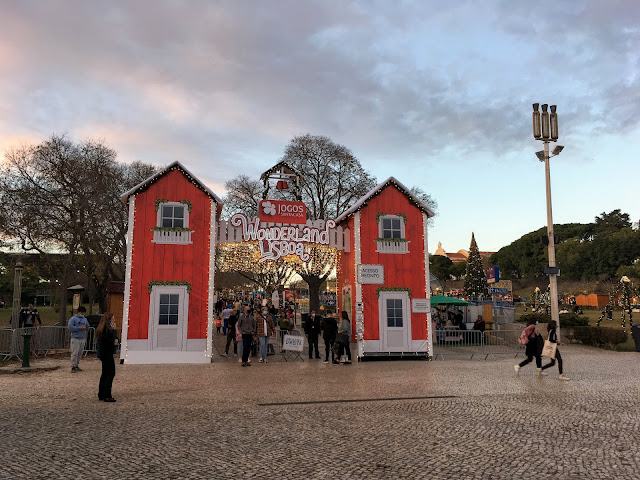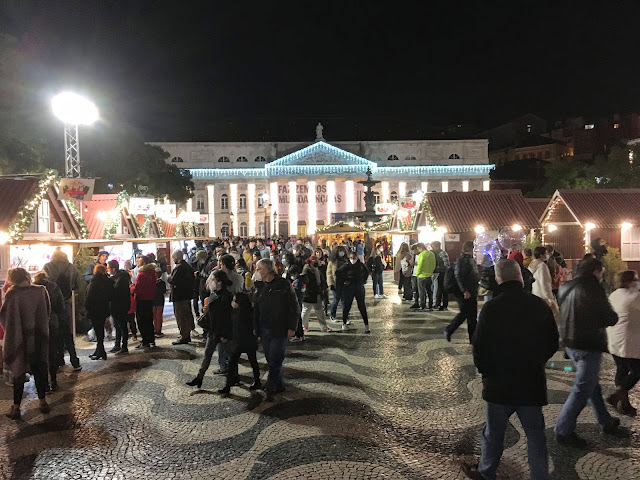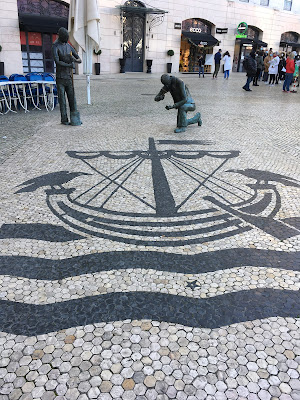On Wednesday we moved to a new Airbnb in a town called Cascais just outside of Lisbon. We rented a car to explore the area and yesterday we took a trip to the touristy town of Sintra. One of the most popular tourist attractions in Sintra is the Pena Palace, a very Disney-eque castle painted in bright red and yellow hues and perched high on a hilltop. Unfortunately for us, on the day of our visit a huge foggy cloud had settled directly on the hill limiting visibility to just a few feet in front of us.
It was not exactly the kind of weather we were hoping for, but we made the best of it and explored what we could.
In an alcove we found an exhibit with a video showing what the view from the castle looks like on a normal day -- you can see all the way to the ocean with great views of the next hill where there are the ruins of a Moorish Fortress.
Contrast that image to the "views" that we had -- when standing on the parapets we couldn't even see the ground below us through the pea soup fog.
There are two options when you buy your Pena Palace ticket -- you can just tour the outside of the castle, or you can add the option to go inside and see the furnished rooms. This is one of the most popular attractions in town, and there were hundreds of people already in line to get inside. So we decided to avoid all the crowds and just stick with the outdoor ticket. Even with the low visibility we could at least still see most of the decoration of the exterior. Some of it was a little bizarre.
Sintra is known for having great hiking trails, so instead of taking the bus or a taxi we decided to hike down the hill back to town. The fog began to lift as we descended, but it still stubbornly clung to the hilltops, which ruined our view of the Moorish fortress -- you can maybe just see it through the veil of fog.
The hiking path that we were on took us right past the Villa Sassetti, a summer house built in the 1890's to resemble an Italian castle.
The gardens of the Villa were beautifully landscaped with lots of exotic-looking flowering plants.
After our hike, we walked back into town and toured the gardens of yet another fancy "castle", the Quinta da Regaleira.
This estate was originally a farm (hence the Portuguese name "Quinta"), but in the 1890's the land was purchased by an eccentric millionaire who wanted to build a palace to live in. On the rest of the property, he wanted to have a garden of curiosities: towers, wells, statues, grottoes -- you name it, he built it. This photos shows a fancy wall with several towers and a grotto...
...After hiking up a series of levels in the garden, you arrive at the "Initiation Well" which isn't actually a well at all but a spiral staircase...
...which leads down into a maze of man-made caves (did I mention that the guy who built this place was eccentric?)...
...where you then walk behind a waterfall...
...to finally emerge back out into the lowest level of the garden. As we came out of the caves, I just happened to glance back up to the distant hills where we had hiked and -- guess what -- the fog had finally cleared and you could see the ruins of the Moorish castle. Unlike the fancy Regaleira and Pena "palaces", the Moorish castle was built back in the 9th century when castles were true strongholds built for defense. The castle remained a Moorish fortress until 1147 when it was surrendered to Christian forces.




















































